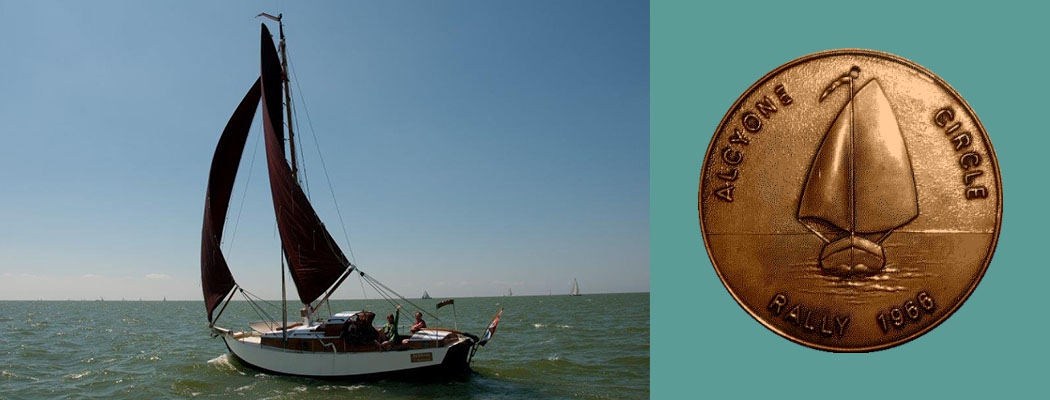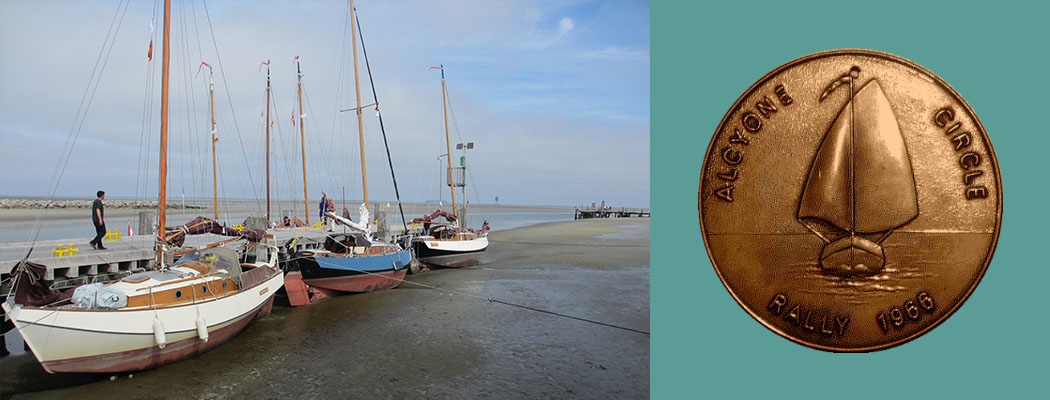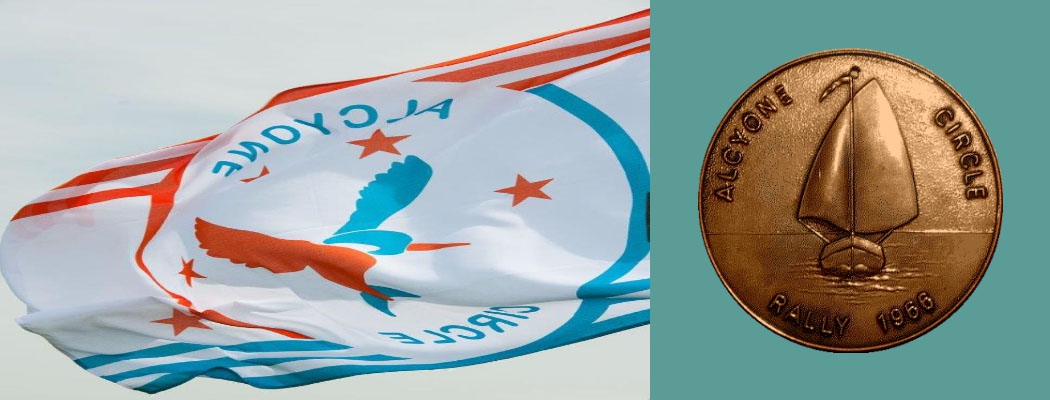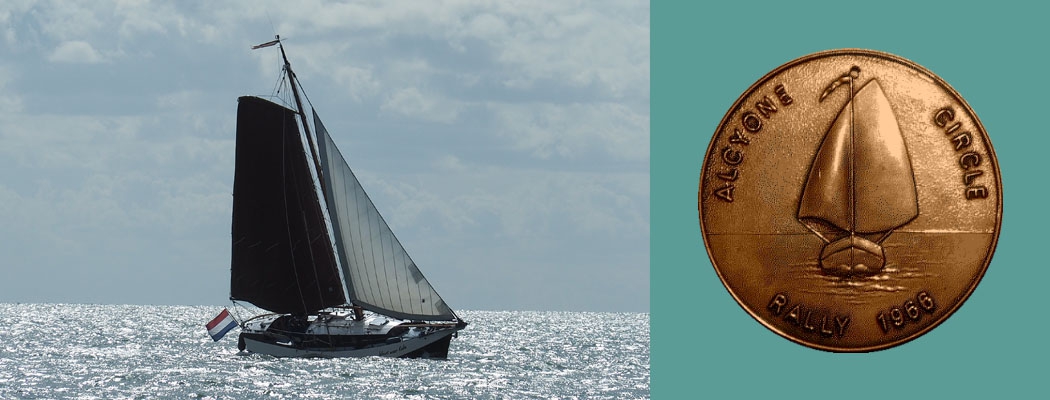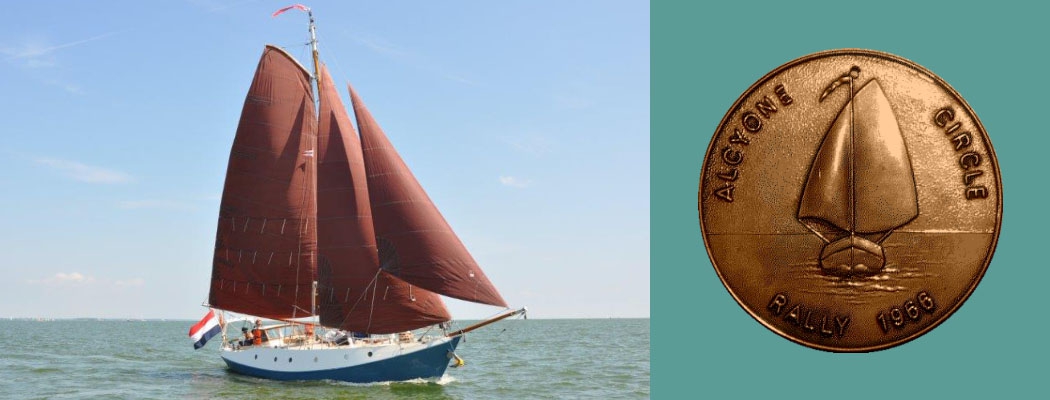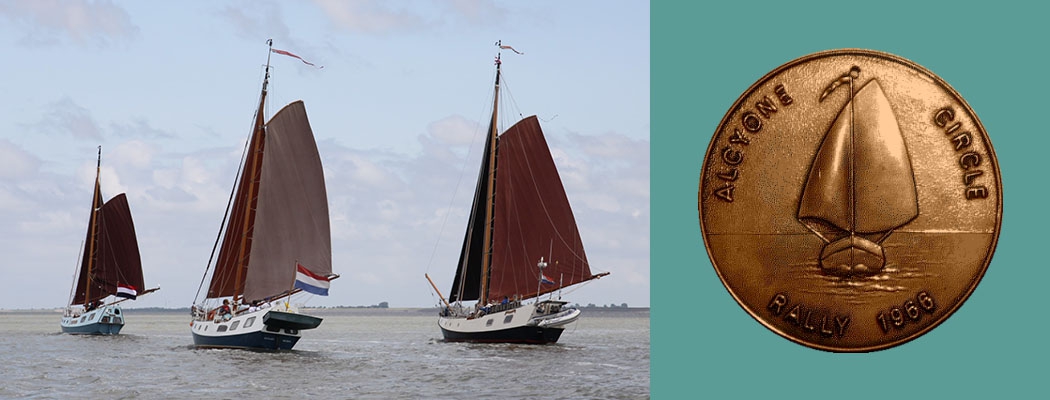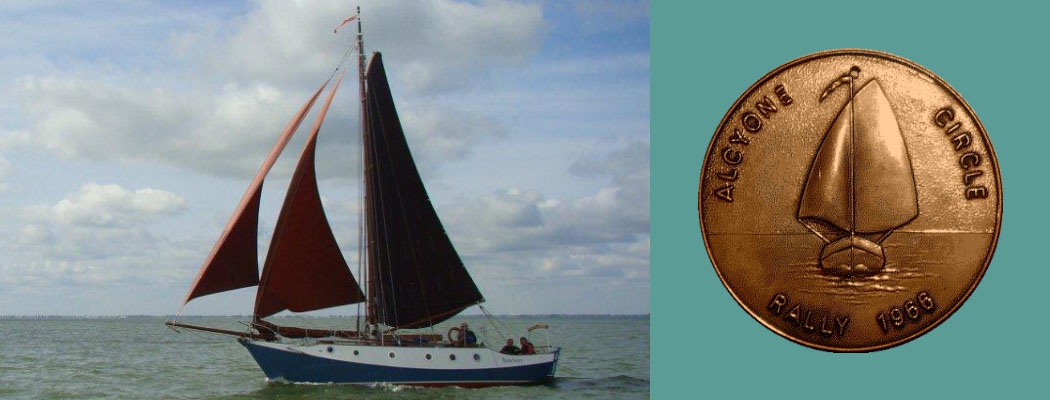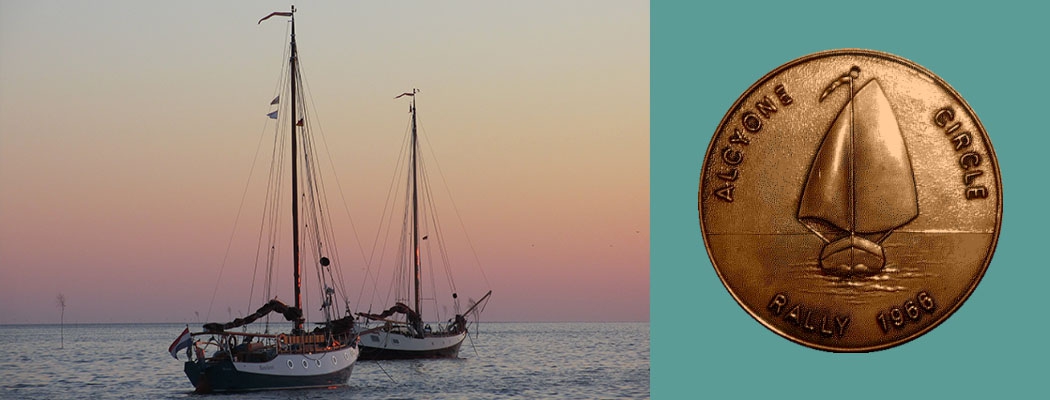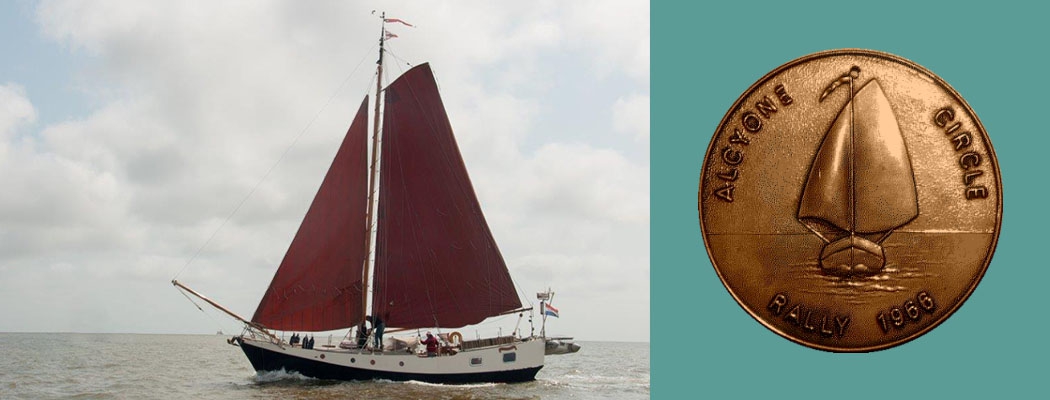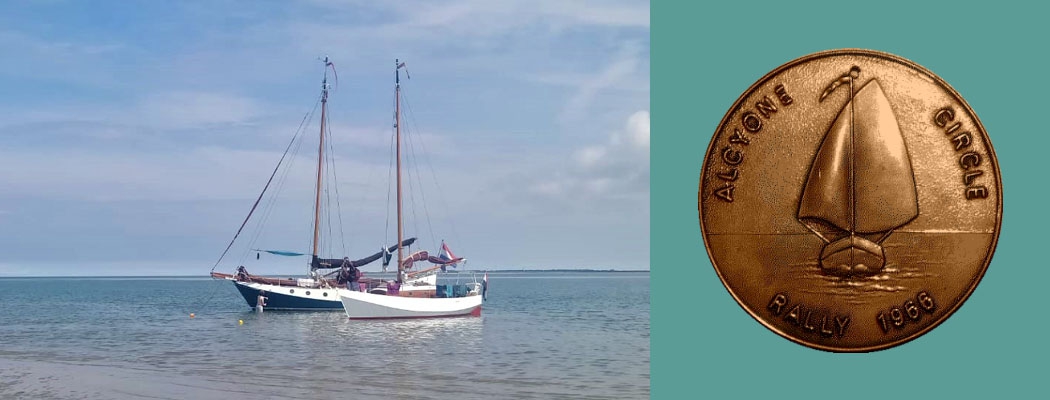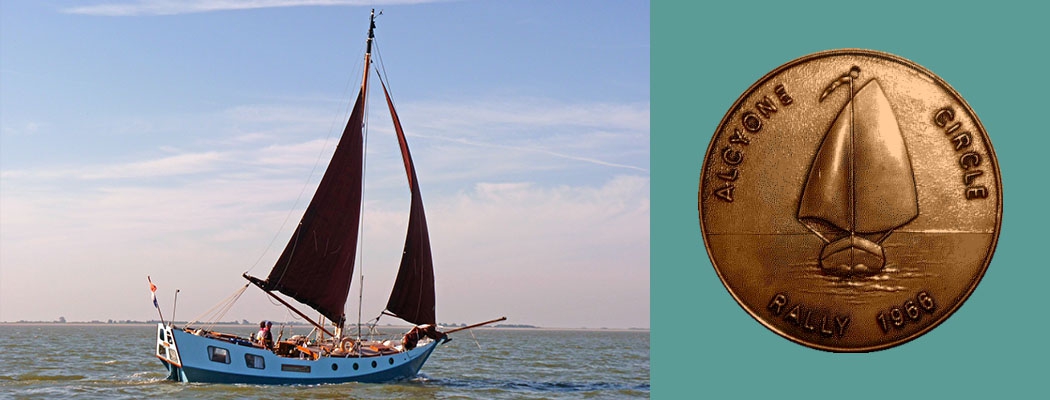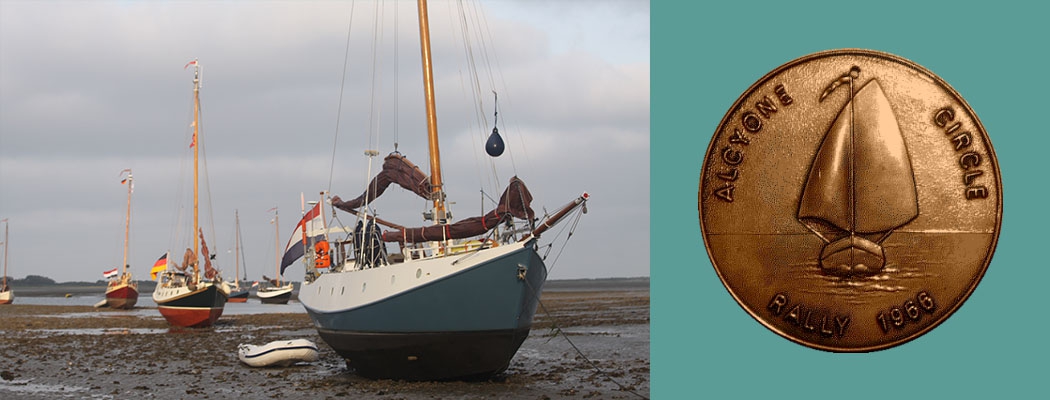 L.S.
L.S.
This is just a newsletter to announce the next Meeting we have planned.
The meeting will take place in the house of Mr. and Mrs. AFJ Dijkgraaf, Hacquartstraat 28, Amsterdam, on Friday January the 31st and will begin at 8 o’clock.
We hope to show some colour slides of the Biesbosch meeting and if time permits Mr. van Marle will show some slides of his tour this year around Scotland.
All the members who are able to attend are requested to write or phone Mrs. Dijkgraaf with how many people will come. (Tel. nr. 020-716606).
In the next newsletter we hope to give a report of our Biesbosch meeting, including some delightful songs of Capt. Sanders, which he made on that occasion.
Spurwing
From Sir Percy Wyn-Harris we just received an account of his journey in “Spurwing” this autumn from Cairns in Australia to Mauritius and we use this opportunity to inset the report of this fine voyage:
The most northerly town of any present note inside the Great Barrier Reef is Cairns and it was there, in September 1967, I wrote my last Christmas letter. Then with Ron Curnow, an Australian architect from Melbourne as crew, “Spurwing” continued her cruise northward inside the Great Reef towards the Torres Strait.
Except for the “big steamers” passing up the regular channel, the infrequent small fishing craft and three yachts, we had this 800 miles of delightful sailing to ourselves. These were grand days, mostly of clear skies decorated with fair weather clouds; days of limpid blue seas, breaking white when the breeze was fresh; brilliant green over sand, dark over deep lying coral, and turning brown where the reefs come up close under the surface; days enlivened by the brisk and sometimes strong south easterlies which blew almost continuously in our favour.
With the rugged coast of Australia on our port hand, we sailed from quiet anchorages in the lee of small islands, usually leaving well before dawn to make our next anchorage in the early afternoon, for nightsailing in these reefs leads to trouble.
We sailed into Cooktown, at the mouth of the Endeavour River – 80 years ago a roaring gold-mining town of character, but now with its thirty seven inhabitants, a ghost, sleeping in the sunlight. An obelisk marks the spot where Capt. Cooke in 1770 beached and repaired the “Endeavour” after her incredible escape from a reef some 20 miles to the south. Cooke’s name sings across the Pacific, but never more than on this coast.
“Spurwing” being flat-bottomed and of a draft of 3 feet, we were able to feel our way up the Endeavour River for some 15 miles – frequently grounding and hauling off the mud-banks which encumber the narrow estuary – until we finally dropped anchor in a deep reach surrounded by dense tropical vegetation; the following day by rubber dinghy and outboard another 10 miles, with flocks of parrots and innumerable other birds chattering and carousing in the trees, the odd wild pig and even a “scrubby” seen dimly in the undergrowth. When the river turned to a clear stream running over pebbles, we abandoned navigation for the luxury of a fresh water bath.
Among other anchorages, we visited Lizard Island with its great lagoon and climbed the mountain from which Cooke described the pass he took through the Great Reef in his attempt to escape to sea from the ever narrowing water between the Reef and the mainland.
Then on to the empty and stately Flinders Group; with turtles and the occasional shark for company, we lay in a shallow lagoon under the rocky hills and feasted on oysters (and as Ron reminds me – champagne) – oysters which Captain Bligh of the “Bounty” rightly called excellent when he sampled them on Restoration Island during his open-boat journey to Timor.
But we had our excitements. Passing through the deep channel which runs between Pipon Island and the boulder stream and towering heights of Cape Melville the strong breeze suddenly gusted up to gale force. A reef broke two cables ahead; with wind against tide and with “Spurwing” carrying too much sail, the ship refused to come about and gave us several nasty moments as, heeled over she drifted rapidly towards the breakers on Pipon Island, close under our lee. However, with the engine started and the centre-board right down our “Spurwing” recollected her manners, came up slowly to the breaking seas, into the wind, filled on the other tack and sped to the open water. We thankfully felt our way in the gathering dark into the lee of Pipon and dropped our hook among – as we discovered at dawn – a platoon of coral heads. It took us all the morning to recover our anchors, although both were buoyed.
Then there was Morris Island the perfect Desert Island Disc with its solitary coconut palm romantic in the sunset. Ron insisted on rowing ashore to gather a coconut, but returned slightly chastened in the deepening twilight, to report that the undergrowth was crawling with rats, who seemed to regard his incursion into their domain with appreciation rather than with apprehension. Even the big eagles had wheeled malevolently about him.
Memories are many. Portland Roads with its war time pier and seven inhabitants, not counting the kangaroos and the taipan snakes, where we first met Terry Martin in his 23 foot “Coral Sea”. Then there was the Japanese pearl farm in the Escape River, the Albany Passage and many other delectable places. And so we came to Cape York, the most northerly point of Australia. As we approached the Cape in a flat calm, acres of the mirrored sea kept shattering as huge shoals of tunny leapt to escape their even larger predators, an unforgettable sight.
And then westward the 30 odd miles to Thursday Island, still with much of the savour of the old days of the Pacific clinging to it – a cheerfully unregenerate population of Pacific Islanders, Australians, Aborigines, Japanese, Europeans, Chinese, Indians and what you will. A notice in one of the Billiard Saloons has the flavour: “Those who play and are drunk, and run away without paying, will kindly pay before leaving.” In the anchorage where the tides run hard, the last rearguard of the great fleet of pearling luggers, fresh in from the pearling grounds still dip to their anchors with ancient copper diving helmets lying green on their decks. But the brave new world is on its way and Thursday Island is rapidly altering under the winds of change.
Then on November 7th last year we turned west once more across the Gulf of Carpentaria – 300 miles – to the empty Wessel Islands – a chain which stretches northwards from the Australian Coast and forms the northwestern side of Carpentaria. Some hours after leaving Thursday Island we caught up with “Coral Sea” and Terry marked the occasion by putting a couple of rifle shots across our bows as we passed.
The Wessel Islands and the barren coasts of Arnhem Land were possibly the highlight of the 1967 voyage. A narrow strait between two of the Wessel chain bore on the chart the magic label “The Gagari Rip or The hole-in-the-Wall” and “Spurwing” found herself taking a look at it. Here the tidal stream, in a deep channel a cable wide pours between the cliffs of two of the islands – usually in hurrying silence but at intervals bursting into a roar as the bottom ends of the rip breaks into curling overfalls. After making a somewhat foolish and alarming acquaintance of the rip in the rubber dinghy, we finally lodged “Spurwing”, when the stream was dead, in a tiny cove halfway down the southern side of the strait. Here surrounded by cliffs we spent a delightful three days lying in still water, while the stream swept up and down the rip a few yards under our stern. A broad ledge led us down the side of the strait to another backwater where we had our own aquarium, with an amazing variety and number of fish: one old rock cod occasionally poked his head out of his hole just below our feet and eyed Ron with gloomy resentment. Every few minutes a shark would swim round scavenging.
We caught hardly enough fish even for an odd meal, for as soon as we hooked a sizeable fish a shark would be in like a shot take the fish and hook himself; then a tug-of-war began until the shark straightened the hook and got off.
Finally, Ron, with two immense hooks, a wire halliard for a trace and an oil drum for a float hooked and landed a seven footer. Then the unhappy thought dawned on us that we had nothing – not even a loose rock – to act as a priest and give him quietus. The shark spat out the hooks and with much threshing hurled himself back into the water.
Just before we left, by this time having a friendly relationship with the rip, we took “Spurwing” on an exhilarating toboggan ride throughout it.
And then by deserted channels to Elcho Island with its large Mission Station of over 40 missionaries and workers tending a settlement of 1500 Aborigines. But we were getting into the hurricane season and after a further few days pottering into some of the splendid inlets on the Arnhem Land coast, we got caught at dark after an airless day on a lee shore by a towering anvil-shaped thunderstorm – which blew for two hours with a most unpleasing ferocity and reminded us that we had outstayed our welcome. So we set sail for Darwin.
Arriving there on a still night early last December, we found that poor Terry had lost his “Coral Sea” in the same thunderstorm which we had so disliked. A 60 knot wind sweeping across the Darwin roadstead had parted “Coral Sea’s” cable and she had driven ashore – an almost total loss.
Darwin is not an ideal harbour for small craft, for in addition to a tidal range of twenty two feet, the long fetch across the wide estuary make the anchorage almost untenable in a blow, as indeed we quickly discovered. Carl Atkinson – a character if ever there was one; erstwhile pearler, a salvage diver of great repute, a thorn in the side of authority and apparently regarded by it as the last of the buccaneers – came to our assistance and borrowing a mobile crane he hauled “Spurwing” out of the water and planted her firmly in Doctor Gully’s alongside his fine launch yard, where she lay safe from the depredations of the toughest hooligans. Carl’s stories would keep “old men from the inglenook”. They certainly did one.
While Ron and I flew out of Darwin on our separate occasions Terry undertook to look after “Spurwing” and he worked mightily over several months; under his hand he got the centre board rebuilt, holes in the hull welded and completed many other jobs; in fact “Spurwing” had quite a refit, and she certainly needed it after ten years of honest work.
On my return to Darwin last June many problems naturally still remained, not the least getting “Spurwing” back into the water, but with a high spring tide, the use of a back end loader to deepen the channel and the largest crane in Darwin she was at last dropped into her element with a run. By August 19th, shorty after Ron had appeared from his architectural labours in Melbourne “Spurwing” lay at the harbour jetty ready for sea. As ever whilst at Darwin we were overwhelmed with kindness, hospitality and help. Athol and Ann Brown and their large and delightful family, who came with us on a memorable sail across the estuary; Dawn and Henry Gebauer, and others will know how much we owe. They all came down to the wharf to see the three of us off and we cast off with mixed feelings; my last impression was of tiny two year-old Nola, the Brown’s enchanting aborigine faster-daughter waving good-bye, in Ann’s arms.
Thus we set out westwards into the Timor Sea on our way to the Indian Ocean. At first the winds were light and as the coast of Australia fell away to the south they faltered and died, leaving us to a glassy calm. Our old one lung diesel was called upon and she hammered away faithfully while flying fish broke from under our bow and scuttered away. Ron reported a veritable sea serpent of imposing proportions and thereafter we kept meeting these sea snakes, some of quite a respectable size but nothing as large as Ron’s first monster. A large hammerhead shark lounging just under the surface also proved a photographer’s model and a diversion in the windless warmth, as we followed him around. But, towards nightfall a breeze sprang up from the south and freshened and so it was that on the fourth day out, at the dawn twilight a fix from sextant altitudes of Sirius and Capella gave our position as 45 miles SSE of Ashmore Reef. As the Admiralty Pilot recorded that there was a passage through the reef on its western side into the lagoon, I decided to see if we could find it. After a complicated plot which kept me at the chart table, Terry late in the afternoon spotted breakers fine on the starboard bow and shortly afterwards a low smudge appeared ahead – West Islet. By the time we had worked round the breaking south west corner of the reef it was too dark to see any gap in the western breakers so we stood off and hove-to about 8 miles away, where we spent an uncomfortable night. But by noon the following day, August 24th, we were back and nosed our way in over the reef where there were no breakers, and found ourselves in the lagoon, which is about ten miles across. We sounded our way southward and anchored in a hole about a mile from West Islet. It was a lovely but deeply desolate place in the middle of the Timor Sea. Sea snakes infested the lagoon, but fish were scarce, Ron and Terry being singularly unsuccessful in their fishing expeditions. On West Islet – a sand bank covered with short sea-grass and half a mile long by three hundred yards wide – we met with incongruity. On the one hand an unmanned Australian Weather Station and a notice informing mariners that there was potable water on one of the other islets on the far side of the lagoon: this was contrasted at the tip of the islet with a bizarre wooden pylon decorated with charms – probably recently erected by Indonesian fishermen – which bore all the signs of powerful witchcraft, complete with sacrifices of birds and turtles. Three unnamed graves, the spume from the reef and the doleful cries of the wheeling sea birds added the last touches of the forlorn.We beached “Spurwing” on the tide as our stern bearing had gone and with a wary eye on the snakes swimming in the ankle deep water we made a temporary repair. Ron regards sea snakes with a friendly interest, while Terry and I kept respectfully out of their way.
After four days we threaded our way across the lagoon and out through the pass – this time finding the channel – and set course for Cocos Keeling Island 1600 miles to the west. As soon as we got clear of the end of the reef, which was breaking in a most magnificent manner, the seas became steep and the motion violent and Terry and I felt it badly for the next few days. Tar contamination in our fresh water tanks added to our discomfort – our water becoming undrinkable – and we had to subsist on a small cup of tea in the morning made from the water intended for our batteries, fruit juice and an occasional warm beer from our small stock. But the wind was fair and fresh, and “Spurwing”, usually with a reef down plunged out rolled along at her best speed – one day making her record noon to noon run of 164 miles. It was at three thirty on the early morning of the twelfth day out from Ashmore, in the dim light of an obscured full moon we picked up the shadowy outline of coconut palms ahead. With no drinking water and Cocos being such a small low landfall I was most relieved to see them appear. We hove to for daylight and at dawn entered the lagoon through the wide passage between Horsborough and Direction Islands. Cocos is an atoll about ten miles across. The reef encircling the lagoon has half a dozen sandy islands on it. The Atoll was settled by a Clunies Ross about 100 years ago who got a perpetual lease for it. The present Clunies Ross keeps feudal state on Home Island where all the 700 Cocos Islanders live and work under his sway. The sovereignty of the atoll has now passed to Australia who maintains an up to date, fully equipped airfield on West Island 89 miles across the lagoon from Home Island. The staff of the airfield and their families number something over 100. As the big jets now overfly Cocos the airfield is seldom used except for the large Electra which flies in from Perth every three weeks with fresh food and stores for the airfield staff. Contact between the two inhabited islands of the atoll is of the slenderest – a remarkable set up.
We anchored in the shallow lagoon off West Island and had a charming welcome from members of the staff of the airfield, who did everything to help us during our stay. Peter Burbrook, the Official Representative of the Australian Government who was in the Colonial Administration in North Borneo, and who is well known to several who read this, rowed out to us on a filthy day, and he and his wife Elizabeth did so much for us. Particularly do I remember two charming days as their guest in the Residency while “Spurwing” was laid up on the slip.
But the anchorage off West Island was hateful when it blew – and the weather while we were at Cocos was both windy and wet; and at dawn on the second day our anchor chain parted. The day of the anchor chain is a story itself – a story mostly of mistakes. The fact we got out of it without serious mishap and recovered both our anchors was due in large part to the stout work of Ron and Terry.
This incident decided me to seek anchorage in the lee of Direction Island which used to be the headquarters of the cable station but now has only a slip, hostel buildings and a workshop; these are even now in the process of being removed. The sole resident on the island is a splendid character Bill Smith, originally from the town of Greenwich, who among other things is looking after the installations until they are removed. Bill took us under his wing in every way and we owe him a lot. With his indefatigable help “Spurwing” was slipped to repair the stern bearing and Frank Medwin, in charge of the airfield workshop made us a new bearing which is working like a charm.
The crew turned to the horrid job of opening up the water tanks under the saloon seats and burning, chipping and sanding the unspeakable paint from the insides of the tanks. The cabin was foul with the fumes of burning paint and the Australian imprecations of the crew against the slick Paint Representative at Darwin who had assured Terry that his firm’s paint was suitable for the interior of drinking water tanks. After a week’s work the crew had got down to the bare metal which they then cement washed.
Jack Sederlund, an American from California in his fine 58 foot ketch “Ta’aroa” with a crew of five, which included two girls sailed in from Bali; we had first met “Ta’aroa” last year at Cooktown. Also Dr. Charlie Gould and his wife Ruth in their lovely 50 foot sloop “Astrocyte” which they had themselves built in Vancouver.
Ron and Terry went in for skin diving and Ron made his first underwater acquaintance with the sharks in the lagoon. To me a horrid encounter even in thought, but Ron apparently enjoyed it and got some good underwater photographs.
It was not until October 3rd that we were ready for sea, and we sailed at noon into a rain squall, just half an hour after “Ta’aroa” and “Astrocyte” had set off for the Seychelles.
The winds were strong for the passage to Rodrigues, a dependency of Mauritius lying nearly 2000 miles to the WSW of Cocos. The motion again was often violent, but “Spurwing” crossed this lonely ocean at a clipping rate and without serious incident. 348 miles in 48 hours was her best. Just before noon on the fifteenth day, we raised the mountains of the island about twenty five miles distant, and then it was a race against the sun, for the island is unlit, is surrounded by reefs and I also lacked any large scale chart of it. We crowded on sail and at 5.00 pm after a splendid but somewhat anxious sail I spotted, in the words of the Admiralty Pilot “Diamond Islet in line with a notch in the hills bearing 221º true” and this led us just at sunset through the pass of the outer reef. A kindly motor boat came out and led us along the tortuous boat channel in the coral which leads to the wharf and village of Port Mathurin. Rodriguez was charming. Jocelyn Forget, the Mauritian Civil Commissioner and Magistrate made us very welcome and we seemed to live in the Residency. He showed us much of the island and we saw something of the stalwart Rodriguans on this little known out post who with so little materially make the most of what is a hard life. It was fun seeing chaps like Father Harry Smith working for “Freedom from Hunger” at the old tasks of village betterment. To go round his Agricultural School and to see something of his agricultural settlements was a heartening experience. Father Reilly who also gave us generous hospitality and good fellowship is another happy memory.
Rodrigues is a poor island and the hurricane “Monique” earlier this year had left its ugly scars in roofless houses and dying trees – there is hardly a mango tree left in many groves. At the height of the hurricane, when the barograph had reached an intimidating low, Father Harry crawled to his Meteorological Station on the top of the hill. In the vacuum in the lee of the shed he almost suffocated, but managed to read the anemometer: it was gusting to 172 miles an hour. The highest figure on the Beaufort scale is believe Force 17 – 136 mph.
At dawn on October 24th with a large group of friendly Rodriguans on the wharf to see us off, we turned “Spurwing” with some difficulty in the tiny basin and threaded our way down the boat channel through the western pass to the open sea. Once clear of the reefs which extend some distance off-shore we took our departure for Mauritius 330 miles further on. On the third evening we raised the mountains of Mauritius and spent an interesting but tiring night sailing up the coast to the north end of the island; at dawn with a fair tide under us we swept through the channel between Flat Island and Gunner’s Quoin, avoiding the rips off the latter and, turning south down the west coast, entered Port Louis with its background of sugar cane and exciting rock peaks, just as the church bells in the town were ringing for morning service.
In the long narrow harbour tiers of Japanese fishing vessels were happily unloading fish into their factory ship before returning to their task of despoiling the small but prolific fishing grounds. I have met the Japanese fishing fleets everywhere – in the Canaries, in the Galapagos, off the islands of the Pacific, off the coasts of Australia and New Zealand. They are killing one of mankind’s golden geese – but why worry – its good fishing while it lasts.
Two 5000 tons Russian Ships – modern and top secret – covered with festoons of strange antennae lay side by side in the harbour like Tweedle Dum and Tweedle Dee, engaged, I am told in picking Russian spacemen out of the drink.
Our stay in Mauritius and the overwhelming kindness we have received must be told later, as this has rambled on unconscionably.
In a few days we must leave for Durban as the hurricane season is now upon us; after that probably into the Atlantic as I think “Spurwing” is beginning to smell the Deben mud once more.

